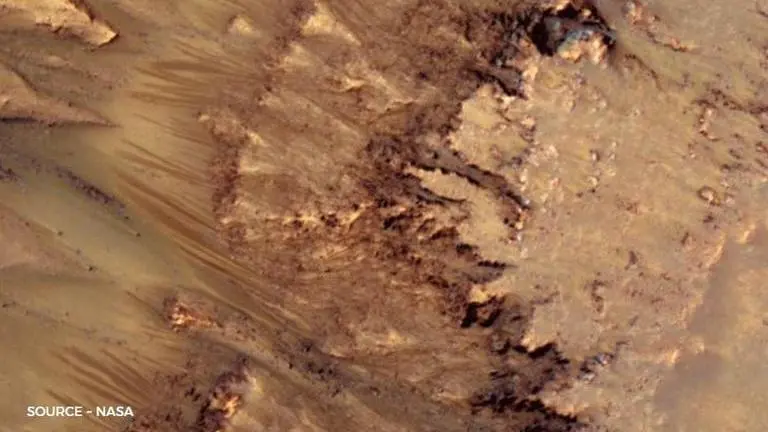Updated 13 February 2021 at 15:10 IST
Mars has mysterious dark streaks and scientists believe it sustained life-like situations
Pictures from Mars show changes in the mysterious dark streaks which is formed by landslides. Scientists experimented on similar soil. Know what they found.
- Science News
- 3 min read

A piece of new evidence found on Mars proves that the planet used to incur landslides. This explains that Mars used to be favourable to host life in it. Published on February 3, 2021, the new study from the journal Science Advances says that scientists have found evidence that a "liquid-like flowing slush" has been created due to the chemical reaction between melting ice and the Red Planet's salty subsurface permafrost.
Scientists find mysterious dark streaks on Mars
The "liquid-like flowing slush" which is mentioned in the journal is actually causing the landslides to leave dark, narrow lines known as recurring slope lineae (RSL) on the Martian surface. However, scientists believe that the icy slush is too salty to harbour life now, but around 2 billion to 3 billion years ago, the Red Planet may have had life prospering. This was first reported by Live Science after the study's lead author Janice Bishop, a senior research scientist at the SETI Institute, sent an email about the same.
According to the report, Bishop mentioned that the scientists have known the existence of landslides on Mars for at least a decade. The previously detected landslides were found near Mars' Palikir and Krupac craters. However, they only had images of small landslides, known as "slumps" and RSLs, taken by NASA's High-Resolution Imaging Experiment (HiRISE) camera.
Advertisement
Image ~ © NASA/ JPL/ University of Arizona
The expansion and migration of the salt crystals through Mars' soil are possibly happening because of the chemical reactions between the sulfate and salt crystals. However, Janice Bishop believes that it is a "very slow process" due to the cold temperatures on Mars. The temperature on the Red Planet is quite freezing as it is believed that it can drop to minus 80 degrees Fahrenheit (minus 62 degrees Celsius) near the streaks.
Advertisement
In the report by Live Science, Bishop also mentioned that in just a few months, the landslides show changes in their shape and structure. The scientist s determined this conclusion by looking at the images recently released by HiRISE. Later the scientists experimented to understand the process better. They brought sulfates, chloride salts, ice particles and volcanic ash that were obtained from a few Mars-like places on Earth like the McMurdo Dry Valley, Dead Sea and the Salar de Pajonales. Then, the mixture was frozen at the temperature similar to that of Mars. However, they observed that before the mixture could melt, the temperature increased. Later the scientists observed that under cold temperatures, the chlorine salt and sulfate separated which resulted in ice water moving between the mixture "almost like passing a soccer ball down the field." This also led to soil degradation and landslides.
According to Bishop's statement to Live Science, Mars does not presently have life, however, we can safely expect that the Red Planet might have had a favourable environment to sustain it just like how other places on Earth which are similar to the planet's conditions. In a statement to Live Science Bishop added: "We don't know yet how the early habitable Mars transformed to modern Mars with a harsh, cold and dry environment".
(Disclaimer: The detailed descriptions of their findings was put up online on February 3, 2021. It can be read in the journal Science Advances.)
Published By : Yash Tripathi
Published On: 13 February 2021 at 15:09 IST
